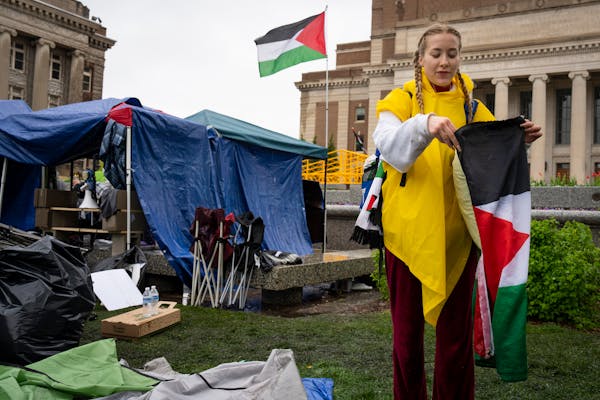HURON, S.D.
A rooster pheasant, its iridescent feathers shimmering in the October sun, rocketed into the blue sky. Two shots dropped the bird, and a veteran Lab quickly found it in tawny grass and delivered it proudly to hand.
"First bird of the season," said Jack Rendulich of Duluth.
It was a classic scene from the South Dakota pheasant opener -- an annual ritual that draws thousands of hunters from across the nation to the acclaimed pheasant capital of the world.
And no state sends more hunters here than Minnesota. Some 24,500 journeyed west last year to pursue wily ringnecks -- more than the next four states combined.
Three Minnesota friends and I have chased roosters in South Dakota for nearly 30 years, and this year we headed for Huron to renew what has become a cherished tradition.
"It's just an incredible atmosphere," said Mike Smith of Cologne, Minn., trying to explain the allure. "It's Big Sky Country, and it goes on forever. Just watching the dogs work -- that's probably the most fun."
We hunted heavily used public lands, but we found birds. We made some great shots, missed some easy ones and were saved on several occasions when our bevy of six hunting dogs found birds we had knocked down. We hunted hard from noon (when hunting began) until sunset. For those keeping score, we shot 28 birds in three days, eight shy of our limit but enough to put smiles on our faces.
As was the case last year, the landscape was brimming with water from summer rains. Sloughs and ditches were filled, spilling over some roads. Three times, my Lab swam to retrieve downed roosters -- usually a rare occurrence.
More than hunting
The Gopher State's impact here was hard to miss: Vehicles with Minnesota plates were at every motel, restaurant, gas station and tavern. But we also saw pickups and SUVs loaded with hunters from Oregon, Tennessee, Illinois, Kansas, New York, New Jersey, Wisconsin, Iowa and Michigan.
Like us, they come for the pheasants, but also for the camaraderie, the wide-open endless landscape and the intangibles, like seeing 50 cackling roosters fly out of a cornfield and into heavy cover at sunset, or watching your hunting dog, its tail quivering, hot on the scent of a bird.
"It's as much a social event as an outdoor recreation event," said Tony Leif, wildlife division director for the South Dakota Game, Fish and Parks Department. "There are all sorts of family reunions and gathering of old friends."
Pheasants also mean money: Hunters spent $220 million in South Dakota last year. At the front desk of our motel was a bowl of dog bones for canine guests and a box of rags for hunters to wipe grime from dogs and gear. Dogs were welcome for an extra $10, and many rooms had four-legged guests. A bird-cleaning station was set up near one entrance.
"Welcome hunters" banners are ubiquitous here. "Hunters, let us do your laundry," read a sign in Huron.
After all, this is Ground Zero for pheasants. Hunters -- about 170,000 of them -- routinely bag 1 million to 2 million ringnecks annually, easily the most of any state. The forecast this year: A harvest of 1.6 million birds, the same as in 2009.
In comparison, about 100,000 hunters shot 400,000 ringnecks in Minnesota last year.
South Dakota residents missing
But not everything is fine in pheasant nirvana. Despite the best hunting in the nation, resident pheasant hunter numbers have been falling in South Dakota (as are duck hunter numbers). Last year, just under 70,000 residents hunted ringnecks, the lowest since 1943.
Nonresidents are filling the gap. Since 2002, nonresidents have exceeded resident pheasant hunters. (The tally last year: 97,350 nonresidents, 69,949 residents.)
What's going on? Officials aren't sure, though nationwide older hunters are falling by the wayside, and aren't being replaced by youngsters.
"We're losing a few hunters every year," Leif said. "It's a concern. Certainly the opportunities are there in terms of bird numbers. We hear access to hunting opportunities is the No. 1 factor that leads them to participate or not participate."
And access might be more difficult for residents because of pressure from hunters willing to fork over $200 daily to hunt private land. Still, there are more than 1.5 million acres of public hunting land.
To encourage hunters, South Dakota offers a special weekend resident pheasant season, and a youth hunt, too. Time will tell if those efforts help boost license sales.
Another season
For my group, a trip to South Dakota is tradition. The opener is only the beginning of a fall filled with days spent with friends -- two-legged and four-legged -- searching fields and fence lines for ringnecks.
Said Rendulich, "It's addicting."
Doug Smith • dsmith@startribune.com
Thursday's prep results

Nylander and Woll help Maple Leafs beat Bruins 2-1 to force Game 7

Wolves vs. Nuggets series updates: Times for first four games set

